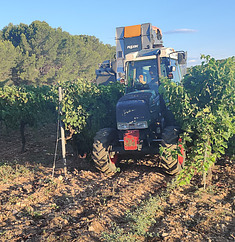
How do you harvest and preserve grapes in France?
In August 2022, I was lucky enough to take part in a HARVEST workshop organized by Domaine de la Courtade! How do you harvest and preserve grapes in France? Well, it is usually the same method, but every winemaker has his little SECRETS! So let me tell you about my day when we followed the grape from the vine to the vats, where they are currently fermenting.
Let’s start by a small presentation on the estate and then we will move on to the technical part.
Domaine de la Courtade – Presentation of the estate
The estate was FOUNDED by Henri Vidal in 1983. It obtained its ORGANIC certification in 1997 and is currently practicing BIODYNAMICS methods. In 2014, the estate was bought by Edouard CARMIGNAC, a famous collector of works of art and who now has his eponymous foundation on the island.
It has 31ha of vines and 27 are used for production. The long term goal is to extend to 37ha. The soil of shale and clay makes it possible to STORE water (rare in Provence) and to let the roots pass so that they find the groundwater, which is located at a depth of 4 meters. The ISLAND of Porquerolles also allows the vines to enjoy a micro-climate and thus avoid hail or thunderstorms that have been happening for a few years at the end of summer on the mainland.
The MAIN grape varieties used are Mourvèdre, Rolle (vermentino) and Grenache. Syrah is also planted to bring finesse to the red and rosé wines and the Sémillon for elegance to white wines. Cinsault also appeared in 2016 and is used in the blending of rosé wines.
They produce TWO cuvées : the Cuvée Terrasses and the Cuvée Courtade. They actually have a THIRD cuvée. It is the same as the Courtade cuvée, except that the bottles spend several months UNDER water, in the Atlantic ocean!
On the label of the former is drawn the island, on the second the MONSTER of Alycastre is represented. What is the monster of Alycastre? Let me tell you a little story in the words of Dominique Amann from his book Dragons et Dracs dans l’imaginaire provençal:
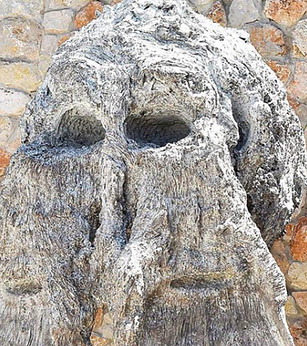 On the island of Porquerolles, in the Var, the fort of the Licastre, or the Alicastre, built in the time of Richelieu, owes its name to a dragon named the Lycastro, former inhabitant of the place. It owes its name to a draconian monster once removed in the place where the fort was built. He came out of his den without fear of being embraced by hunger and found his pittance in the surrounding countryside, making his prey of the most beautiful specimens of the animals that grazed, when he did not attack, the gueux, the shepherds who guarded them. The inhabitants of the island had been trembling for a long time to know this here when, on a sad December night, a pilgrim returning from the Holy Land was engulfed, with the boat carrying him, by the raging sea. Alone of all the passengers, he was thrown by the waves on the shore. The islanders, who discovered him the next day, treated him so much that he came back to life. Having regained his strength, he inquired how he could discharge his rescued hosts, but the latter, who had acted only out of charity towards their Christian brother in the trial, refused the slightest thanks. Someone having incidentally revealed to him the existence of the Lycastra, the pilgrim immediately armed himself from head to toe and went to the dragouniero: he discovered the sleeping monster, his belly exposed to the sun, digesting. The brave man planted his spear in the body thus offered. The beast, twisted in pain, forced the knight to let go and turned against his opponent, his mouth wide open to devour him. The valiant warrior, who had drawn his sword, drove it into his throat, inflicting on the animal a mortal wound by the hemorrhage produced. The story even specifies that before taking his last breath, the dragon begged his victor to give his name to this place.
On the island of Porquerolles, in the Var, the fort of the Licastre, or the Alicastre, built in the time of Richelieu, owes its name to a dragon named the Lycastro, former inhabitant of the place. It owes its name to a draconian monster once removed in the place where the fort was built. He came out of his den without fear of being embraced by hunger and found his pittance in the surrounding countryside, making his prey of the most beautiful specimens of the animals that grazed, when he did not attack, the gueux, the shepherds who guarded them. The inhabitants of the island had been trembling for a long time to know this here when, on a sad December night, a pilgrim returning from the Holy Land was engulfed, with the boat carrying him, by the raging sea. Alone of all the passengers, he was thrown by the waves on the shore. The islanders, who discovered him the next day, treated him so much that he came back to life. Having regained his strength, he inquired how he could discharge his rescued hosts, but the latter, who had acted only out of charity towards their Christian brother in the trial, refused the slightest thanks. Someone having incidentally revealed to him the existence of the Lycastra, the pilgrim immediately armed himself from head to toe and went to the dragouniero: he discovered the sleeping monster, his belly exposed to the sun, digesting. The brave man planted his spear in the body thus offered. The beast, twisted in pain, forced the knight to let go and turned against his opponent, his mouth wide open to devour him. The valiant warrior, who had drawn his sword, drove it into his throat, inflicting on the animal a mortal wound by the hemorrhage produced. The story even specifies that before taking his last breath, the dragon begged his victor to give his name to this place.
You can check out their website here for more information.
Step 1 – Destemming and crushing

To CHOOSE the date of the harvest, the level of ripeness of the grapes are controlled by the taste (if the taste is sweet, the harvest is approaching) AND in the laboratory. Indeed, the estate has its own laboratory. These winemakers are also chemists!
On the 10th of August, harvest had begun! On this estate, the whole harvest is done using a harvester (30ha is a LOT of vines to harvest!).
The harvester will go through each row of the vineyard. The vines are shaken to enable the grapes to fall into the tank, where they are destemmed.
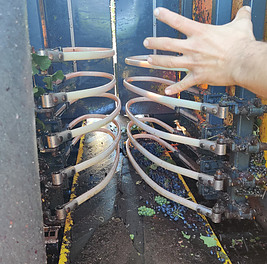 The harvester then pours the grapes into a truck to be brought to the cellar.
The harvester then pours the grapes into a truck to be brought to the cellar.
These mechanically harvested grapes arrive without stalk and are then poured into a CRUSHER before being poured (under the effect of gravity) into the PRESS. Crushing bursts the skin of the grapes and releases the drop juice. Of course, the seeds should not be crushed. They would then release their bitter tannins, making the wine astringent.
Step 2 – Pressing
Pressing consists of SEPARATING the liquid and solid constituents from the reason. In the case of white wines, it is made before the start of fermentation, whereas for red wines it takes place after.
The press used at the Domaine de la Courtade is a PNEUMATIC press. How does it work? It consists of an inflatable RUBBER membrane placed inside a perforated horizontal stainless steel cylinder, which allows pressing in a controlled way. For rosés, the time of pressing is about an hour and a half to two hours, for Domaine de la Courtade anyway.
The juice is then sent by means of sheath directly into the tanks to minimize contact between the juice and oxygen.
The must extracted at the beginning of pressing is very DIFFERENT, in terms of flavor and texture, from the one obtained at the end. The winemaker can thus decide to SEPARATE these juices from different pressings and to vinify them individually. They will contribute to the BLENDING to create the style of wine wanted by the winemaker. Indeed, once the maceration is complete, the free-run juice is removed to retain only the skins, which are then pressed to obtain the press wine. At the beginning of pressing, the composition of this wine may be SIMILAR to that of free-run wine, but it gradually becomes more intensely COLORED and tannic. Hereunder, you will find an example with Syrah, at the start of the press and 10 minutes after.
Indeed, on this 19th of August 2022, Domaine de la Courtade had just finished harvesting their Syrah for their rosé wines. Syrah being a very colorful grape, they proceeded by direct pressing. The grapes are crushed and then pressed as for white wines.
Another way to make rosé wine, and is perhaps used for other of their grape varieties is the short maceration.
The red grapes are crushed and macerated to extract flavors and color.
Step 3 – Fermentation
For fermentation, the winemaker can choose to use indigenous yeasts, present in the PRUINE of the grapes and in the vat room, or to add to the must a selected yeast.
At Domaine de la Courtade, the SECOND approach is preferred. The first has been attempted but has not, for the moment, proved conclusive: indeed, indigenous yeasts can confer a great AROMATIC complexity to the wine but the winemaker does NOT master it. Moreover, it can cause variations between lots.
The yeasts currently available on the market are specifically selected strains of S.Cerevisiae. They are sold DRIED to the estate which will have to rehydrate them at 37 ° C and gradually lower the temperature to 15 ° C to avoid any thermal SHOCK when they are poured into the wine at 12-15 ° C.
At Domaine de la Courtade, they sometimes use the yeast 71-B to help START the fermentation when it is needed. (it is the same yeast used for Beaujolais Nouveau, which gives it a banana aroma, dear to our friend Georges Duboeuf. But to learn more, I invite you to read my article on Beaujolais.)
Indeed, thermoregulation is very important in winemaking because if the temperature of the wine in fermentation increases too much, the yeasts die.
This technique also allows the winemaker to INFLUENCE the flavors of the wine. Fermentation at low temperatures, for example, preserves the most VOLATILE aromas, often floral notes. It can also promote the appearance of FRUITY flavors in white wines. Conversely, HIGH temperatures are required to extract color and tannins from the skin for red grapes.
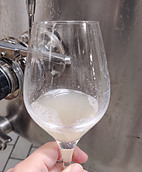
The winemakers at Domaine de la Courtade gave us an EXAMPLE with their sémillon. They had their vat at 10-15 ° C which gave the wine aromas of strawberry Tagada and banana. They have now raised the temperature to 17 ° C to have more freshness in his wines. Indeed, for white wines, a temperature too low leads to the appearance of notes of English candy, and it is then impossible to preserve the primary English aromas.
The fermentation cuvées are therefore under PERMANENT supervision to guarantee an appropriate temperature. Most are now equipped with their own cooling system, which facilitates this thermoregulation.
For red wines, fermentation is done in contact with the skins. A thick layer of pulp and skins quickly is formed on the surface of a red wine (the cap). The extraction of color, flavors and tannins remains then very limited.
There are thus many “hat management techniques“: pigeage, pumping-over and tub changing. At the Domaine de la Courtade, in order to stay GENTLE the grapes, it is the second method that is preferred. This consists of extracting the fermenting juice from the bottom of the tank to pump it over the top, thus wetting the cap. It is also a very good way to dissipate heat and oxygenate the wine.
The wines in fermentation are MONITORED daily, by extraction of a sample and a verification of its characteristics in the laboratory.
For different reasons, it is sometimes necessary to adjust one or more of the main components of grape juice (grape must). These adjustments can be made before, during or after fermentation. The winemaker may, for example, choose to increase the SUGAR amount in the juice by adding rectified concentrated must in order to raise the degree of final wine alcohol (the yeasts would then have a greater amount of sugar to convert). But it is FORBIDDEN in many areas. On the contrary, the ACIDITY level can be increased by adding tartaric acid powder. However, in Europe, this treatment is allowed only in warm regions.
Step 4 – Clarification of musts
The wines are then sometimes “glued” or filtered in one way or another to improve their CLARITY and stability. At the Domaine de la Courtade, they use PEA protein! These are vegetable glues and are not subject to labeling requirements (non-allergenic). In the specific case of rosés de PROVENCE, they make it possible to reduce the coloring intensity and eliminate more significantly the phenol compounds responsible for the yellow and red color on the juices of end of press and oxidized juices, which results in a shade more pink, less orange.
ALL IN ALL, the grapes come from the vine and go in the harvester. The latter pours the grapes in a truck which will bring these grapes to a hole where the crush pad is. They go then directly to the press (this was the case today) and will stay there for two hours maximum. They will then sent to a vat where the fermentation will take place, after adding dome yeasts. It usually starts under two days.
In the cellar, the next step will be the aging (in vat or barrel), then the blending and finally, the wine will be put into bottles to be sold and consumed by the customer (IE US!)
In the vineyard comes the pruning from November to January. At that time, it will be necessary to choose the branch to cut. For this, the winemaker follows the path of the sap and will make his choice at the end… But this is for another time…





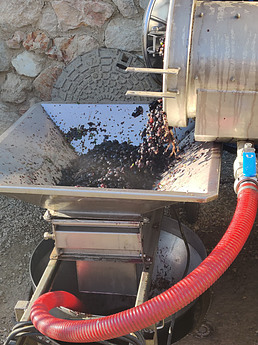
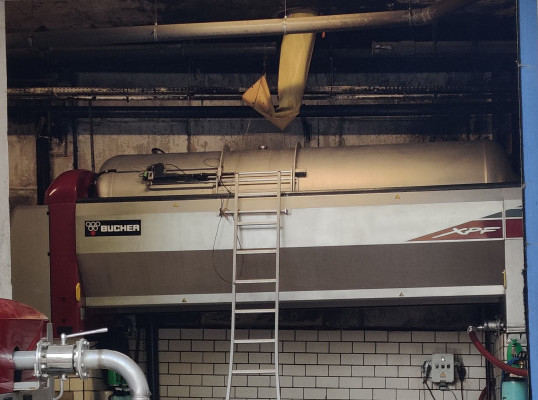
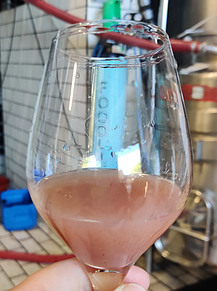
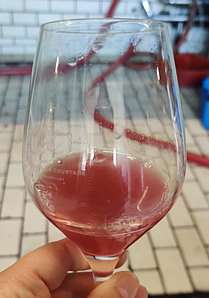
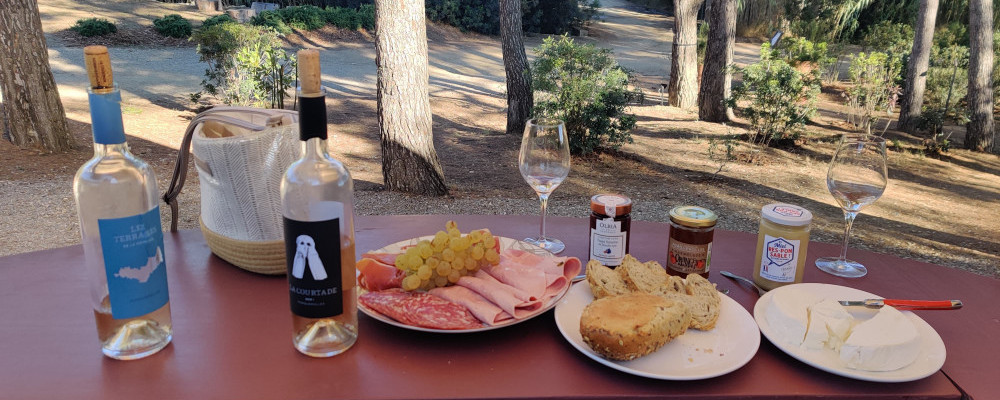
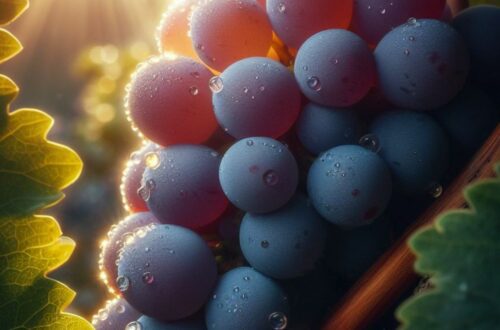
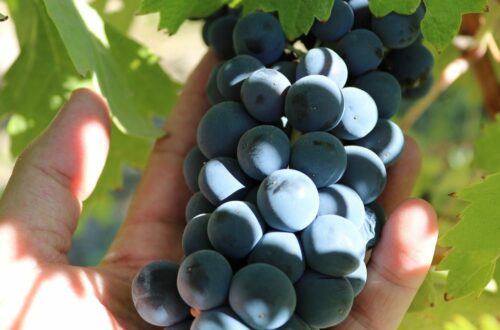
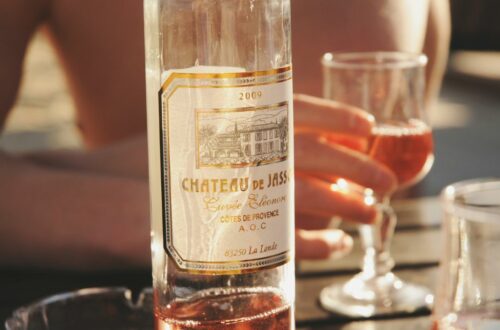
4 Comments
franck
Very interesting!
Mademoiselle
Thank you! It was an amazing morning! It is not often we are able to witness and participate in such an experience!
pasindu dimanka
Many thanks for this valuable and detailed post about harvest and preserve grapes. Actually, this has some very interesting steps. I came to know about this today. Can this be fixed only by using this machine? Can’t we fix the house? Keep posting like this. I will definitely share this.
Mademoiselle
Thank you for stopping by! What do you mean by fixing the house?
To answer your other question : harvest is also done by hands in other vineyards (who have different requirements). But a harvester does the job, especially for high volumes. Hand harvest is best for old vines, because they are more fragile, or if you want to hand select the grapes but usually that would be for a low-yield production. The harvester does the job for any other production